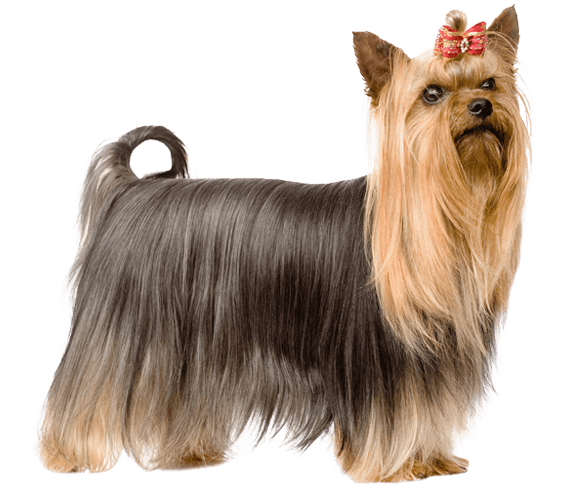Yorkshire Terrier Breed Maintenance
One of the things that many parents like about the Yorkshire Terrier is that they have no undercoat, meaning they’re hypoallergenic and ideal for those who’d prefer their homes to be free of copious quantities of dog hair.
However, you might need to become a bit of an expert in grooming a dog as a Yorkie’s coat can grow to rather impressive — and annoying for them — lengths if left untended.
This means brushing the coat at least once a day and ensuring the facial fur is trimmed or tied back into a topknot to stop it from irritating the eyes. In addition to this, a Yorkie needs a bath once a week and their ears should be checked for signs of infection weekly, too.
Once cherished as a lapdog, the Yorkie needs more exercise than you might think. Two short walks a day should suffice, as well as occasional runs in the backyard.
Be sure to keep them mentally stimulated with lots of toys, too — you can even have a go at replicating the obedience and agility rounds that so many Yorkies have competed in at dog shows throughout history.
Yorkshire Terrier Health Risks
It’s a well-known fact that smaller dogs tend to live longer than larger breeds. Yorkies are no different. While the average Yorkshire Terrier lifespan is between 11 and 15 years, some have been known to reach their late twenties.
This isn’t to say that every Yorkie is the picture of health, however. As with every breed, there are some conditions and illnesses that are sometimes passed down the generations.
Patellar luxation
A bone condition that’s common in toy breeds, patellar luxation – also referred to as luxating patella – can be roughly translated from medical speak as ‘dislocating kneecap’.
The patella should run smoothly along a groove on the femur as the knee straightens and bends. However, when the kneecap luxates, it protrudes out to either side, which cancause intermittent bouts of limping and stiffness in the back legs. Over time, the condition can lead to arthritis.
If you notice early signs of patellar luxation in your pet, you should alert your vet quickly, as they can offer treatment options. In mild cases, they might suggest physiotherapy, but more severe instances might require surgery. Pain relief can also help.
It’s important for parents to stop Yorkie puppies jumping too high when they’re young, as this can increase the likelihood of a luxating patella emerging in later life.
Keep your Yorkshire Terrier protected against a wide variety of health problems with a wellness plan geared around their needs — take a look through some of the best options available from top insurers here.
Legg-Calvé-Perthes Disease
Another hereditary condition that’s sometimes seen in teeny-tiny dogs is Legg-Calvé-Perthes Disease. This one affects the hip joint and happens when the blood supply to the area decreases, leading the top of the femur bone to eventually degrade and die.
Although bone issues are usually associated with senior canines, Legg-Calvé-Perthes tends to start young, as soon as five months in some dogs. The first signs parents will often notice are limping, lameness, muscle shrinkage and pain in the hind legs. It usually only affects one hip joint, rather than both at the same time.
Your vet will be able to diagnose the condition by taking X-rays of the trouble area and surgery is often the next course of action. For smaller breeds, this usually entails laying down new tissue to create a false joint — hip replacement is rare for toy breeds.
The good news is that Legg-Calvé-Perthes is both rare and can be successfully cured in the majority of cases when caught early enough.
Eye issues
As well as occasionally suffering from dodgy bones, Yorkies are no strangers to eye problems as well. Some of these are genetic and difficult to treat, including progressive retinal atrophy and corneal dystrophy. Both of these lead to impaired vision later in life.
However, there are other eye problems that can be solved with the assistance of a vet. Cataracts, for example, can also be hereditary in Yorkies, although surgical interventions can often stop a dog’s vision from completely deteriorating.
There are other conditions for which parents might have to give their pet eye drops. These include droopy eyelids, dry eyes or watery discharge. In certain cases, it’s important to keep a Yorkie’s coat from growing and coming into contact with their sensitive eyes.
Feeding a Yorkshire Terrier - what’s the best diet?
You might assume a dog the size of a Yorkie won’t need much food to get by and it’s true that their digestive system can’t hold a great amount at any one time. However, you’ll notice soon enough that they have bundles of energy, so this needs to be replenished.
This is especially true for Yorkie puppies and it’s sometimes necessary to schedule as many as four meals a day to provide them with all the nutrients they need at this vital stage of life. You can usually lower to twice-daily meals as they get a little more mature.
Dog food designed for smaller breeds will be richer in calories and denser in nutrients than equivalents for larger breeds, as tiny dogs don’t need to eat as much before they feel satisfied. Toy-breed kibble is usually smaller in size as their mouths are, well, smaller.
Still unsure of what to feed your Yorkie? Our partner Dog Food Advisor has compiled a comprehensive list for this tiniest of breeds — take a look at the best dog food for Yorkies here.






